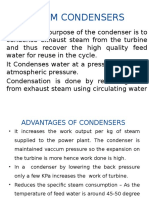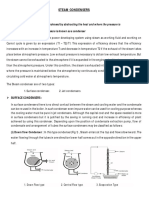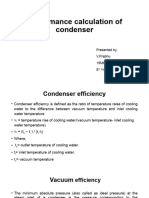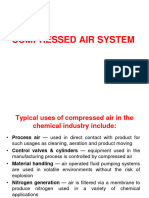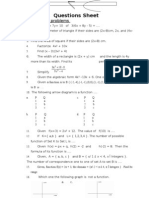0 ratings0% found this document useful (0 votes)
33 viewsSteam Condensers and Cooling Towers
Steam Condensers and Cooling Towers
Uploaded by
ذال شراحبئيلThis document discusses steam condensers, Dalton's law of partial pressures, and cooling towers. It provides information on:
1) How Dalton's law relates to the total pressure in a condenser being equal to the sum of the partial pressures of steam and air.
2) The purposes and types of steam condensers, including surface condensers which allow condensate to be reused.
3) Sources of air leakage into condensers and how it reduces vacuum pressure and efficiency.
4) How cooling towers are used to cool condenser water by exposing it to atmospheric air through evaporation.
Copyright:
© All Rights Reserved
Available Formats
Download as PPTX, PDF, TXT or read online from Scribd
Steam Condensers and Cooling Towers
Steam Condensers and Cooling Towers
Uploaded by
ذال شراحبئيل0 ratings0% found this document useful (0 votes)
33 views22 pagesThis document discusses steam condensers, Dalton's law of partial pressures, and cooling towers. It provides information on:
1) How Dalton's law relates to the total pressure in a condenser being equal to the sum of the partial pressures of steam and air.
2) The purposes and types of steam condensers, including surface condensers which allow condensate to be reused.
3) Sources of air leakage into condensers and how it reduces vacuum pressure and efficiency.
4) How cooling towers are used to cool condenser water by exposing it to atmospheric air through evaporation.
Original Title
Condenser Lect
Copyright
© © All Rights Reserved
Available Formats
PPTX, PDF, TXT or read online from Scribd
Share this document
Did you find this document useful?
Is this content inappropriate?
This document discusses steam condensers, Dalton's law of partial pressures, and cooling towers. It provides information on:
1) How Dalton's law relates to the total pressure in a condenser being equal to the sum of the partial pressures of steam and air.
2) The purposes and types of steam condensers, including surface condensers which allow condensate to be reused.
3) Sources of air leakage into condensers and how it reduces vacuum pressure and efficiency.
4) How cooling towers are used to cool condenser water by exposing it to atmospheric air through evaporation.
Copyright:
© All Rights Reserved
Available Formats
Download as PPTX, PDF, TXT or read online from Scribd
Download as pptx, pdf, or txt
0 ratings0% found this document useful (0 votes)
33 views22 pagesSteam Condensers and Cooling Towers
Steam Condensers and Cooling Towers
Uploaded by
ذال شراحبئيلThis document discusses steam condensers, Dalton's law of partial pressures, and cooling towers. It provides information on:
1) How Dalton's law relates to the total pressure in a condenser being equal to the sum of the partial pressures of steam and air.
2) The purposes and types of steam condensers, including surface condensers which allow condensate to be reused.
3) Sources of air leakage into condensers and how it reduces vacuum pressure and efficiency.
4) How cooling towers are used to cool condenser water by exposing it to atmospheric air through evaporation.
Copyright:
© All Rights Reserved
Available Formats
Download as PPTX, PDF, TXT or read online from Scribd
Download as pptx, pdf, or txt
You are on page 1of 22
STEAM CONDENSERS AND COOLING TOWERS
Evaluate condenser performance
and select for proper application.
DALTONS LAW OF PARTIAL PRESSURE
• “Thetotal pressure exerted by mixture
of gases or a mixture of gas and vapors
(which have no chemical action on each
other) is equal to the sum of the partial
pressures of the constituents of the
mixture, if it occupies the volume of
mixture at temperature of mixture”.
DALTONS LAW OF PARTIAL PRESSURE
• The total pressure in the condenser is the
sum of the partial pressure of steam and air.
• Pressure of mixture= partial pressure of
steam + partial pressure of air
• So according to Daltons law total pressure
in the condenser is, Pc = Ps + Pa
Where , Pc= total pressure in condenser
Ps= partial pressure of steam
Pa= partial pressure of air.
DALTONS LAW OF PARTIAL PRESSURE
Pc Ps Pa
Steam + air steam Air
Steam condenser
• A steam condenser is a closed vessel in to which
the steam is exhausted, and condensed after
doing work in an engine cylinder or turbine.
• A steam condenser has the following two object:
• 1) the primary object is to maintain a low
pressure (below atmospheric pressure) so as to
obtain maximum possible energy from steam
and thus to secure high efficiency.
• 2) the secondary object is to supply pure feed
water to the hot well, from where it is pumped
back to boiler.
Classification of steam condenser
• The steam condensers may be broadly classified in to the
following two types, depending upon the way in which the
steam is condensed.
• 1) jet condensers or mixing type condensers
a) Parallel flow jet condenser
b) Counter flow jet condenser
c) Barometric or high level jet condenser
d) Ejector condenser.
• 2) surface condensers or non mixing type condensers.
A) Down flow surface condenser
B) Central flow surface condenser
C) Regenerative surface condenser
D)Evaporative condenser
Surface condenser
• A surface condenser has a great advantages over the jet
condenser, as the condensate does not mix up with
cooling water.
• As a result of this whole condensate can be reused in
the boiler.
• This type of condenser is essential in ships which can
carry only a limited quantity of fresh water for the
boilers.
• Fig . Shows a longitudinal section of a two pass surface
condenser.
Surface condenser
Surface condenser
• It consist of a horizontal cast iron cylindrical
vessel packed with tubes, through which the
cooling water flows.
• The end of the condensers are cut off by
vertical perforated types of plates into which
water tubes are fixed.
• This is done in such a manner that the leakage
of water into the centre condensing space is
prevented.
• The water tubes pass horizontally through the
main condensing space for the steam.
Surface condenser
• The steam enters at the top and is forced to
flow down words over the tubes due to the
suction of the extraction pump at the
bottom.
• The cooling water flows in one direction
through the lower half of the tubes and
returns in opposite direction through the
upper half.
Source of air leakage
• The following are main sources through which the
air may enter the condenser:
• The dissolved air in the feed water enters into the
boiler, which in turn enters into the condenser with
exhaust steam.
• The air leaks into the condenser, through various
joint, due to high vacuum pressure in the condenser.
• In case of jet condensers , dissolved air with the
injection water enters into the condenser.
Effect of air leakage
1) It reduces vacuum pressure in the
condenser.
2) Since air is poor heat conductor, particularly
at low densities, it reduces the rate of heat
transmission.
3) It requires a larger air pump. Moreover, an
increased power is required power is
required to drive the pump.
Condenser efficiency
• The condenser efficiency may be defined as the ratio
of temperature rise of cooling water to the vacuum
temperature minus inlet cooling water temperature.
• ᶯc = temperature rise of cooling water/(vacuum
temperature- inlet cooling water temperature)
• ᶯc = (to – ti ) / (tv-ti)
• Where, to= outlet temperature of cooling water.
• ti= inlet temperature of cooling water.
• tv= vacuum temperature
Vacuum efficiency
• The minimum absolute pressure (also called as ideal
pressure) at the steam inlet of a condenser is the pressure
corresponding to the temperature of the condensed
steam.
• The corresponding vacuum (called ideal vacuum) is the
maximum vacuum that can be obtained in a condensing
plant, with no air present at that temperature.
• The pressure in the actual condenser is greater than the
ideal pressure by an amount equal to the pressure of air
present in the condenser.
• The ratio of the actual vacuum to the ideal vacuum is
known as vacuum efficiency.
Vacuum efficiency
• ᶯv= actual vacuum /ideal vacuum
• Actual vacuum= barometric pressure- actual
pressure
• Ideal vacuum = barometric pressure- ideal
pressure
Cooling tower
• The main application are in power plants and
refrigeration plants.
• Its function is to cool the hot water from the
condenser by exposing it to the atmospheric air, so
that the cold water may be used again for circulation.
• The cooling towers are used in steam power plants
where there is a limited supply of cooling water.
• It is placed at a certain height (at about 9 meters
from the ground level).
Cooling tower
• The hot water falls in radial sprays from a
height and the atmospheric air enters from
the base of tower.
• The partial evaporation of water takes
place which reduces the temperature of
circulating water.
• This cooled water is collected in the pond
at the base of the tower and pumped in to
the condenser.
Types of cooling tower
1) Natural draught cooling tower
The circulation of air is produced by the
pressure difference of air inside and outside
the cooling tower.
2) Forced draught cooling tower
The circulation of air is produced by means of
fans placed at the base of tower.
3) Induced draught cooling tower
The circulation of air is provided by means of
fan placed at top of tower.
Natural draught cooling tower
Forced water cooling tower
Induced draught cooling tower
You might also like
- Test Bank For Theory and Practice of Counseling and Psychotherapy 10th Edition by CoreyDocument9 pagesTest Bank For Theory and Practice of Counseling and Psychotherapy 10th Edition by CoreyRichard Johnson100% (28)
- Training On Steam CondensersDocument33 pagesTraining On Steam CondensersMayank Gupta100% (1)
- Jiva Goswami Gopala CampuDocument255 pagesJiva Goswami Gopala CampuJSK100% (1)
- Chapter No-5 Steam Condensers and Cooling Towers Marks-16Document22 pagesChapter No-5 Steam Condensers and Cooling Towers Marks-16Vera WidyaNo ratings yet
- Condenser Cooling Towers 216Document28 pagesCondenser Cooling Towers 216rajushamla9927No ratings yet
- STPL STEAM CONDENSERSDocument33 pagesSTPL STEAM CONDENSERSnombusonndlovuNo ratings yet
- Steam CondenserDocument26 pagesSteam CondenserPushkar Pandit100% (1)
- Condensers and Cooling TowerDocument27 pagesCondensers and Cooling TowerVenkateswarlu VelisalaNo ratings yet
- CondensersDocument34 pagesCondensersShreyash VihirghareNo ratings yet
- Daltons Law of Partial PressureDocument14 pagesDaltons Law of Partial PressureDev PatelNo ratings yet
- 9 Condenser-1Document50 pages9 Condenser-1as2899142No ratings yet
- Presentation By: 3 Year Mech-D 17985A077 17985A078 17985A079 17985A083 17985A084 17985A088 17985A092 17985A095 17985A098Document15 pagesPresentation By: 3 Year Mech-D 17985A077 17985A078 17985A079 17985A083 17985A084 17985A088 17985A092 17985A095 17985A098pranav100% (1)
- Chapter 7 - Steam CondensorDocument43 pagesChapter 7 - Steam Condensorrrhoshack100% (1)
- ME 310a Steam Turbines: Cooling TowersDocument33 pagesME 310a Steam Turbines: Cooling Towersshivkumar shindeNo ratings yet
- Steam Condenser - Lecture SlideDocument43 pagesSteam Condenser - Lecture SlideKing KNo ratings yet
- CondenserDocument8 pagesCondenserManish Maurya100% (2)
- TesfayDocument29 pagesTesfayfisahabirhane16No ratings yet
- Reflux Problems: CH Venkatesh 13021A2536Document14 pagesReflux Problems: CH Venkatesh 13021A2536Venkatesh ChNo ratings yet
- Steam CondenserDocument16 pagesSteam CondenserAtharv MarneNo ratings yet
- Heat ExchangersDocument29 pagesHeat ExchangerscooLkiD1412No ratings yet
- Steam CondensersDocument32 pagesSteam Condensersaadhithyarajasekaran100% (1)
- Chapter 5 Steam CondenserDocument40 pagesChapter 5 Steam CondenserHabtamu Tkubet Ebuy100% (1)
- Thermal Engineering-CondenserDocument17 pagesThermal Engineering-CondenserJayNo ratings yet
- Condenser Efficiency EngineeringDocument9 pagesCondenser Efficiency Engineeringโอม ปามาติกะ100% (3)
- Steam CondensersDocument59 pagesSteam CondensersBLACK GAMINGNo ratings yet
- KIET Group of Institutions, GhaziabadDocument8 pagesKIET Group of Institutions, GhaziabadSandeep ChhabraNo ratings yet
- Surface Condenser Operation Steam Surface Condenser Air RemovalDocument10 pagesSurface Condenser Operation Steam Surface Condenser Air RemovalJohn Noel TalandronNo ratings yet
- Steam Condenser: Me 420 - Me Laboratory 2Document74 pagesSteam Condenser: Me 420 - Me Laboratory 2daan100% (1)
- Vacuum SystemDocument28 pagesVacuum SystemSam100% (1)
- Vacuum SystemDocument28 pagesVacuum SystemDalveer Singh100% (1)
- Condenser8 5 2020Document3 pagesCondenser8 5 2020anupnaskar naskarNo ratings yet
- Cooling TowerDocument22 pagesCooling TowerFatin AnisahNo ratings yet
- Condenser in Power PlantDocument20 pagesCondenser in Power PlantPrabir Kumar Pati100% (1)
- PP Ws CondenserDocument14 pagesPP Ws CondenserBhaskar AnupamNo ratings yet
- CondenserDocument17 pagesCondenserMOHD SAIFNo ratings yet
- Steam Condensers: 3/28/2015 1 Footer TextDocument23 pagesSteam Condensers: 3/28/2015 1 Footer TextKumari YehwaNo ratings yet
- Chapter One: CondenserDocument10 pagesChapter One: Condenserشاكر العاقل100% (2)
- Cooling Tower SMMDocument42 pagesCooling Tower SMMFalgun VichareNo ratings yet
- Vacuum SystemDocument49 pagesVacuum Systemssmith2007100% (4)
- Performance Calculation of Condenser: Presented By, V.Prabhu 15M636 5 Yr BE SW MechDocument17 pagesPerformance Calculation of Condenser: Presented By, V.Prabhu 15M636 5 Yr BE SW MechBalaji RajaNo ratings yet
- Turbine TestsDocument30 pagesTurbine TestsReeyan Dave DagandanNo ratings yet
- Unit 2Document26 pagesUnit 2Sruthy SabanthNo ratings yet
- Forced Draft Cooling TowersDocument21 pagesForced Draft Cooling TowersJustin SibonghanoyNo ratings yet
- Steam Turbine Auxiliaries Question & AnswersDocument10 pagesSteam Turbine Auxiliaries Question & AnswersLaxman Veerepalli100% (3)
- CondensersDocument25 pagesCondensersARSAL HASHMINo ratings yet
- Condensate SystemDocument35 pagesCondensate SystemSam100% (8)
- Condensor and Cooling TowerDocument25 pagesCondensor and Cooling TowerYASH ACHARYANo ratings yet
- Condensers PDFDocument29 pagesCondensers PDFsandhya100% (1)
- Thermal Power PlantDocument29 pagesThermal Power Plantshamna AbdullaNo ratings yet
- pptPPE (15&17)Document22 pagespptPPE (15&17)HarshitNo ratings yet
- Condenser PDFDocument14 pagesCondenser PDFnirmalk1222No ratings yet
- PEPOI Condenser Performance BasicsDocument26 pagesPEPOI Condenser Performance BasicsFranz MonsantoNo ratings yet
- Steam Condensers: Unit 4Document12 pagesSteam Condensers: Unit 4sameer jain100% (1)
- Condenser S and Cooling Towers: By, Prof. M.B. GohilDocument55 pagesCondenser S and Cooling Towers: By, Prof. M.B. Gohilanilm130484meNo ratings yet
- Requirements of Steam Condensing PlantDocument9 pagesRequirements of Steam Condensing PlantHung NguyenNo ratings yet
- Cooling Tower Mto-2017Document28 pagesCooling Tower Mto-2017Priyank kanjariyaNo ratings yet
- Ppe Steam CondenserDocument27 pagesPpe Steam CondenserNilesh SinghNo ratings yet
- Cooling TowerDocument25 pagesCooling Towerj4b92tcnxvNo ratings yet
- Compressed Air SystemDocument65 pagesCompressed Air SystemHARSH DHOLAKIYANo ratings yet
- Module 5-Multi-Stage Air CompressorDocument26 pagesModule 5-Multi-Stage Air Compressoramit3184No ratings yet
- Mechanics of the Household: A Course of Study Devoted to Domestic Machinery and Household Mechanical AppliancesFrom EverandMechanics of the Household: A Course of Study Devoted to Domestic Machinery and Household Mechanical AppliancesNo ratings yet
- TDS LF-301Document1 pageTDS LF-301Ofer ShochetNo ratings yet
- JJC 2008 H2 Chem - StoichiometryDocument12 pagesJJC 2008 H2 Chem - Stoichiometrybrianfletcher182No ratings yet
- Questions Sheet: Do The Following ProblemsDocument3 pagesQuestions Sheet: Do The Following ProblemsAnonymous Szetd1No ratings yet
- Importance of TensesDocument2 pagesImportance of TensesSeren ÇandırNo ratings yet
- 0 Eating Out Lesson PlanDocument3 pages0 Eating Out Lesson PlanManastirea ContNo ratings yet
- 100 Cases in General Practice-Freemedicalbooks2014Document224 pages100 Cases in General Practice-Freemedicalbooks2014HumaMihai100% (10)
- Mid Day MealDocument16 pagesMid Day MealPooja VermaNo ratings yet
- Unit 7 Test - Print - QuizizzDocument4 pagesUnit 7 Test - Print - QuizizzTeacher CharyNo ratings yet
- Class-12 PhysicsDocument5 pagesClass-12 PhysicsCrazy about JunglesNo ratings yet
- Periodic Test 1Document2 pagesPeriodic Test 1Dhyan ShahNo ratings yet
- Computation of Income of A FirmDocument6 pagesComputation of Income of A FirmKhushbu GuptaNo ratings yet
- Christ The Savior Is Born - Pres. Russell M. Nelson - Dezembro 2002Document5 pagesChrist The Savior Is Born - Pres. Russell M. Nelson - Dezembro 2002Rodrigo MacedoNo ratings yet
- Hematology (CBC Profile) : MR. No. 21112288369 Loc: GH Lab No. Collection: Name: Gender: Male Age: 48 YearsDocument1 pageHematology (CBC Profile) : MR. No. 21112288369 Loc: GH Lab No. Collection: Name: Gender: Male Age: 48 Yearsejhon edonNo ratings yet
- MIL - Manipulative Information and Media LMSDocument7 pagesMIL - Manipulative Information and Media LMSAlex Casuga100% (1)
- Mill Tutorial PDFDocument201 pagesMill Tutorial PDFDaniel SalinasNo ratings yet
- Sci ScriptDocument4 pagesSci Scriptren whahahhaNo ratings yet
- Kidney Stones - K.S. GopiDocument4 pagesKidney Stones - K.S. GopiMahmood MuftiNo ratings yet
- Marketing Research ProposalDocument8 pagesMarketing Research ProposalZohair Abbas100% (2)
- 2.1 Configuring DNS FilteringDocument3 pages2.1 Configuring DNS FilteringJaja JajagfNo ratings yet
- Salad DressingDocument43 pagesSalad DressingTim Lane67% (3)
- The Basics of ElectrophotographyDocument4 pagesThe Basics of Electrophotographyjimmy calderonNo ratings yet
- Summary NotesDocument22 pagesSummary NoteschandoraNo ratings yet
- AutocoidDocument7 pagesAutocoidIdrissa ContehNo ratings yet
- BE Allotment R1 PDFDocument745 pagesBE Allotment R1 PDFJay Rameshbhai ParikhNo ratings yet
- Curriculum FinalDocument116 pagesCurriculum Finalapi-643881078No ratings yet
- Emmy NoetherDocument2 pagesEmmy NoetherLeanne NequiaNo ratings yet
- What Is VeneerDocument45 pagesWhat Is Veneeraliyah khalidNo ratings yet
- Four Terminal ResistanceDocument9 pagesFour Terminal ResistanceAline RochaNo ratings yet





















